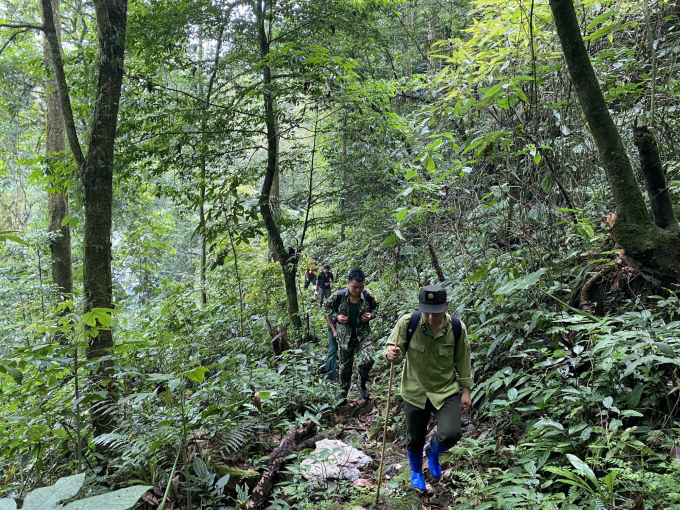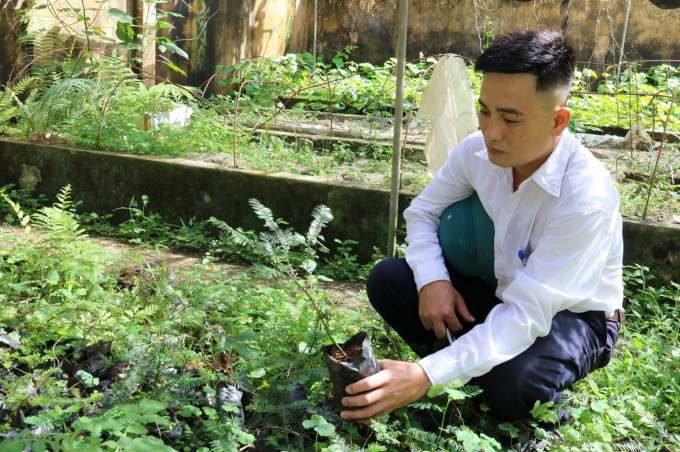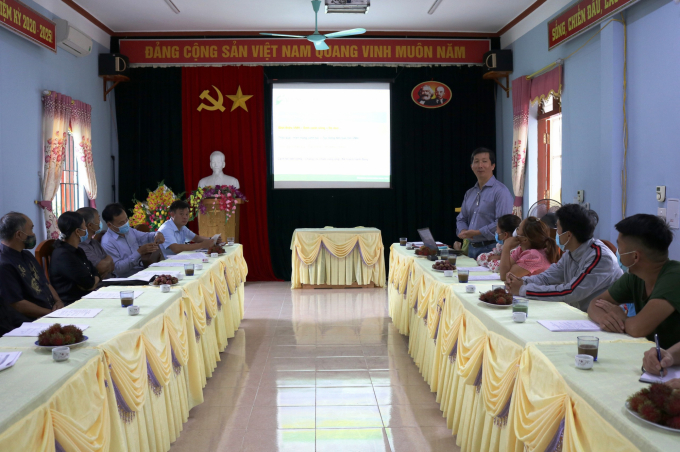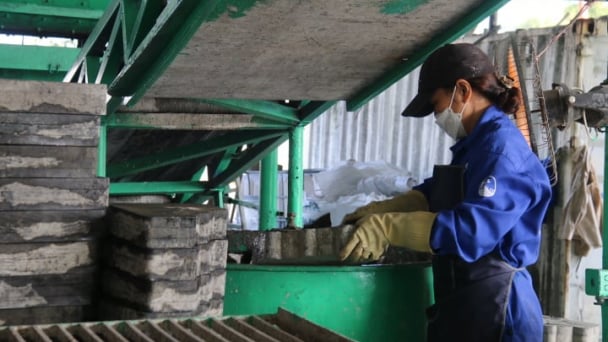May 19, 2025 | 02:49 GMT +7
May 19, 2025 | 02:49 GMT +7
Hotline: 0913.378.918
May 19, 2025 | 02:49 GMT +7
Hotline: 0913.378.918
According to experts from Fauna & Flora International (FFI), there are currently only about 250 snub-nosed langurs left in the world, with four species. In which, 3 species are in China and 1 in Vietnam. The snub-nosed langur in Vietnam is a special species of our country (found only in Vietnam).
Immediately after the discovery of this species in Ha Giang, FFI cooperated with the Provincial People's Committee and the Provincial Forest Protection Department to conduct conservation activities.

Snub-nosed langur living in the forests of Ha Giang province. Photo: Le Khac Quyet - FFI.
Since 2015, the Prime Minister has issued Decision No. 1377/QD-TTg establishing Du Gia National Park - Dong Van Karst Plateau on the basis of merging Du Gia Nature Reserve with Khau Ca snub-nosed langur Nature Reserve, with a total area of 15,006 ha in 3 communes of 3 districts in Ha Giang province, including: Tung Ba (Vi Xuyen district); Minh Son (Bac Me district) and Du Gia commune (Yen Minh district), of which over 11,224 hectares are strictly protected. As a result, the number of snub-nosed langurs has increased significantly, from 60 individuals (in 2002) to over 60 individuals (in 2019).
In 2007, a population of snub-nosed langurs estimated at 32-35 individuals was discovered in the forest area of Cao Ma Po, Ta Van, Tung Vai communes (Cao - Ta - Tung) of Quan Ba district.
To date, this is considered the second largest snub-nosed langur population and is closely related to the population in Khau Ca. As noted by FFI, the number of langurs here is declining sharply from 30 to 35 (in 2007) to only about 10 now due to human activities impacting their habitat.
Facing the decrease in the number of snub-nosed langurs in Cao - Ta - Tung, FFI experts said that the conservation of the snub-nosed langur in Quan Ba district is very important, because survival of a species is difficult if there is only a small population in Khau Ca, due to random incidents of diseases, disasters... which can cause the population to decline, it is necessary to have other populations to backup and create diversity in genetic resources.
Mr. Duong Van Khai, FFI's livelihood advisor said: The snub-nosed langur lives in forests with about 80% coverage. The snub-nosed langur in Quan Ba district currently lives in a small forest of 10 square kilometers and completely isolated from adjacent forests.

Quan Ba district forest ranger patrolling and cheking the number of snub-nosed langurs. Photo: FFI.
To date, there are only about 5,000 hectares of forest with suitable habitat for snub-nosed langurs at Theng Chu Pin, Dao Dai Chai, Ta Lay, Tung Lau mountain, hill 754 and the forest along the Vietnam-China border from mark 283 to 285.
According to village elders and village chiefs in the communes near the snub-nosed langurs, local people often call the langurs Tu Cang, Ca Dac or Mo Pen. The snub-nosed langur is characterized by black fur; creamy white arms, thighs, face and head; patches of orange hair at the throat…
In the past, people used to go to the forest to set traps to hunt and bring them home for meat or cooking. They only learned later that it was a rare species of langur, close to extinction, and implemented conservation.
Mr. Chu Xuan Canh, FFI's Project Manager in charge of Ha Giang province said: Local people's hunting and exploitation of forest products and especially black cardamom cultivation under the forest canopy for many years has seriously threatened the survival of this species due to the shrinking forest area.
Through patrolling and surveying by FFI staff and local partners, people are seen to bring guns into the forest to hunt, set traps as well as harvest timber.
By now, local people's hunting activities have been limited, but authorities have not been able to control all these hidden activities. Although the province has implemented a program to mobilize and seize homemade guns from the people.
According to an investigation by the forest ranger, currently, households living around the langur area are still hiding homemade guns in the forest. Community conservation groups are still reporting gunshots sound in the woods. This has directly threatened the survival of this rare primate.
Conservation of snub-nosed langurs not only protects an endangered primate species on earth, but also contributes to protecting forests, living environment for people, and creating sustainable livelihoods for native peoples.

The nursery for conservation of endangered plant species in Bat Dai Son Nature Reserve in Can Ty commune (Quan Ba, Ha Giang) is funded by FFI. Photo: FFI.
Head of Quan Ba District Forest Protection Department, Mr. Nguyen Ba Ngoc, who is the coordinating partner of FFI's activities in Quan Ba, said that since 2008, FFI has had a project to support the conservation of snub-nosed langurs and orchids in Quan Ba district, including the following activities: building 2 patrol stations in Cao Ma Po and Tung Vai forests for a forest patrol team consisting of 9 members to patrol 15 days/month and check the number of snub-nosed langurs.
At the same time, build boards, signs and leaflets to communicate to the people; livelihood support for people in the 3 communes of Cao - Ta - Tung such as lending to livelihood groups, up to 30 million VND/household without interest, each commune allows 5 households to lend money to buy pigs, cows, goats to raise so that local people search for a livelihood in the forest.
Besides, 2 nurseries of rare and precious plants are set up in Tung Vai and Can Ty communes and distribute them to people for reforestation; made an improved cardamom drying oven to reduce the amount of firewood used to dry cardamom; organized a seminar to develop a cardamom-friendly market for snub-nosed langurs…
Despite this, illegal logging of forest products still happens; Farming activities along with firewood burning to dry cardamom in the forest for many years have greatly affected the habitat of the snub-nosed langur.
With the losing habitat, the population shrinks, cornering this langur species.
Mr. Ngoc said that it is necessary to urgently promote the establishment of the Species and Habitat Conservation Area and the Management Board of the Snub-nosed Langur Species and Habitat Conservation Area, gradually form tourist attractions and ecological services.

A workshop for cardamom market development friendly to snub-nosed langurs . Photo: FFI.
The planned area to establish the Snub-nosed Langur Species and Habitat Conservation Area in Quan Ba district in Cao Ma Po, Tung Vai and Ta Van will be over 3,000 hectares.
At the same time, the locality needs to strengthen leadership and direct the management, protection and development of forests in the area. Focus on propaganda in many forms, strictly handle deforestation, illegal exploitation, encroachment of forests, create a deterrent to violators.
Mr. Chu Xuan Canh, FFI's Project Manager in charge of Ha Giang province shared: If a Snub-nosed Langur Species and Habitat Conservation Area is established in the forest area of Cao - Ta - Tung, it would greatly facilitate the conservation of this langur.
In particular, it will attract the attention and investment of foreign NGOs in langur conservation and livelihood support for local people.
In order to help the snub-nosed langur develop in a difficult locality like Ha Giang, it is necessary to have more support and responsibilities from all levels, sectors, organizations and the society in the protection and revival of this endemic primate species.
In particular, the key is still to raise awareness within the community, along with helping them to stabilize their lives and increase income by protecting the snub-nosed langur.
The snub-nosed langur is one of the 25 most endangered primate species in the world currrently. They are classified as “critically endangered – CR” both in the Vietnam Red Book and the IUCN Red List (World Red List).
In 1912, scientists discovered the snub-nosed langur in Tran Yen (Yen Bai). From 1992 to 2002, biologists have discovered a number of populations of snub-nosed langurs in Na Hang, Touch Chu (Tuyen Quang) and in Bac Kan province, but by now, this species has disappeared from the above provinces.
In January 2002, scientists discovered a population of snub-nosed langurs with a large number of about 60 individuals in Khau Ca forest (Ha Giang). As noted by scientists, this is the largest population in Vietnam.
Translated by Nguyen Hai Long

(VAN) Deputy Minister Nguyen Quoc Tri also expressed his hope that Cuba will soon overcome its current challenges, attain food security, and further expand cooperation with Vietnam.

(VAN) The project contributes to enhancing the resilience of communities vulnerable to the impacts of climate change, with a primary focus on local women.

(VAN) Green materials help save energy and resources. However, after more than 10 years, Vietnam has only developed over 200 green buildings with more than 6 million square meters of floor space.

(VAN) Vietnam - Thailand Business Forum 2025: One plus one on three connects, marking a milestone in the comprehensive strategic partnership between the two nations.

(VAN) The United Nations designated 22 May as the International Day for Biodiversity 2025 with the theme 'Harmony with nature and sustainable development.'
![Multi-channel, multi-directional Vietnamese agricultural markets: [8] A national strategy is needed](https://t.ex-cdn.com/nongnghiepmoitruong.vn/608w/files/phucpm/2025/05/15/1435-thi-truong-nong-san-viet-da-kenh-da-huongbai-8-can-mot-chien-luoc-quoc-gia-084750_728.jpg)
(VAN) The Chairman of Hung Nhon Group shared: ‘Opening up and tapping into new markets is the right and strategic direction for Vietnam's agricultural sector.’

(VAN) Food waste has become a serious issue in modern society, especially in rapidly urbanizing and developing cities like Hanoi.